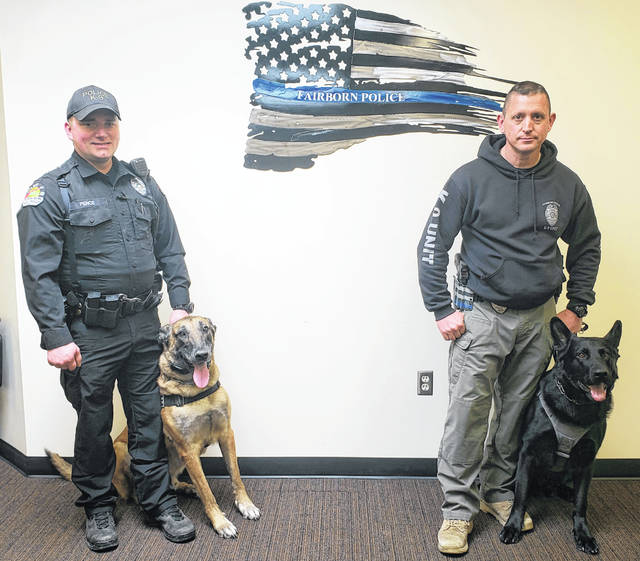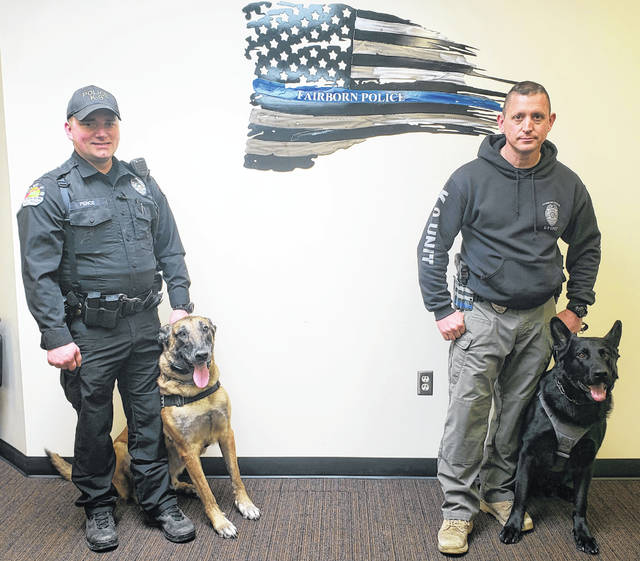

FAIRBORN — Since dogs can’t talk, it took Fairborn police three or four times to figure out what Bac, a police dog, was trying to tell them.
A few years ago, the Fairborn K-9 unit was serving a warrant in the house of a suspect’s mother. Wanted on felony charges, neighbors tipped police that they saw the man at the property, but police were never able to find him while conducting a search. By the recollection of K-9 officers Rod Myers and Joe Pence, while sniffing out the basement of the house, Bac displayed a change of behavior, indicating the suspect was nearby.
At first, officers thought Bac may have been fooled. An air duct in the basement may have been wafting the suspect’s smell from other parts of the house. However, when Bac repeatedly indicated in that area, officers realized the situation might not be quite as it seemed.
The space under the stairs to the basement had been covered in a sheet of plywood. Betting on Bac’s incredible sense of smell, Myers began pulling at the sheet of plywood.
Something pulled back.
The officers found that the suspect had carved himself a hole just large enough to contain himself under the stairs, and screwed a handle on the inside of the wood, hiding himself, a radio, water and some snacks.
“That was, without a doubt, one of the most awe-inspiring moments I’ve ever seen with a dog,” Pence said of the incident.
K-9 dogs are trained to do a lot of things, but their tasks come down to three main points: finding evidence, finding people, and finding illegal drugs. Dogs are trained in narcotics detection, tracking down criminals, and tracking down items that may have been dropped by a fleeing suspect.
“Most dogs have the olfactory ability to do incredible things with their nose,” Myers said. “Basically what we as trainers do is train the dog to use the ability they already have at our request and under the circumstances we dictate.”
Police dogs are rigorously selected based on certain criteria.
“Most of these dogs are very high alpha,” Myers said. “They’re very courageous, they have no fear, they’re very dominant animals, and those are some of the traits that enable us to do our job very effectively.”
Though they are trained to apprehend a fleeing suspect, neither Bac nor Nico have ever had to bite anyone. Most of the time, the intimidation factor is enough. Simply seeing the dogs is enough to convince most criminals to stand down.
“We’ve had so many people that want to fight us, that are fleeing, or going to do violent things, then the dogs come out and it changes their minds completely,” Pence said.
K-9 handlers will give their dogs commands in a variety of languages, most commonly German or Dutch when not in English. Contrary to popular belief, they don’t do his in order to prevent potential criminals from giving commands like “heel” or “sit,” but simply because the dogs were born and raised in Europe. Police dogs begin their training as puppies, and are already familiar with commands in these languages.
“It’s a lot easier for me to learn those commands than to try and re-teach him in another language,” Pence said.
The vast majority of police dogs used in the United States are sourced overseas, typically in Germany or the Netherlands. Bac, a Belgian Malinois, is from Holland. Myers’ dog, Nico, is a German Shepherd born and raised in Czechoslovakia. Both dogs even have passports.
Nico and Bac were acquired from European breeders by Gold Shield Canine Training, which operates out of Columbus, Ohio. Gold Shield has selected and trained K-9 dogs for units across the state. Police dogs typically train for six to eight weeks before meeting their police unit partners, and then train another six to eight weeks more with their handler, according to the officers. Despite the rigorous training that both dogs and officers go through, just like humans, their learning is lifelong.
“The training never stops,” Myers said. “It’s like an officer that comes out of the academy with some feeling like ‘okay, I’m a cop, I know what I’m doing,’ and then you hit the street and realize you really don’t. Your training has just begun. Same thing with the dogs. The dogs come out of their training with a basic foundation, and then we hone that, fine tune it, and build upon it.”
Myers and Pence say they typically have 10 to 20 “deployments” in a month, but their jobs are much more than just major incidents. Often they will go to other crime scenes in a supporting role, providing backup in case one of their dogs is needed. If a situation has the potential to turn violent, dogs have the ability to respond quickly and effectively.
“We don’t necessarily get the dogs out and get them involved, but they’re there in case something goes completely awry. Sometimes their presence is needed and that’s all that’s needed,” Pence said. “That’s not a deployment, that’s a win.”
A common misconception about these four-legged public servants is that their job makes them naturally aggressive. But for the dogs, it’s part of the job.
“They do human apprehensions,” Myers said. “They are trained under certain circumstances to latch on to a fleeing suspect and hold them until we can arrest them. But people equate that to the dog being vicious and predisposed to bite people, which is not the case. They come home with us, they live with our families, they act almost as a regular family dog,” Myers said.
Well, almost. A day off for a police dog is almost like a day on.
“As much as I’d like to say it’s relaxing, because they’re a high-energy breed, it’s a lot of exercise. The last thing my household needs is a well-rested Bac,” Pence joked.
Even playtime is training for Nico and Bac. Playing fetch is also time to practice, reinforce commands and the like. Unlike their civilian dog counterparts, they have a higher standard to follow, even when they’re not on the clock. But when it is time to go to work, the dogs know they have to be ready.
“There is a bond that is formed just like you would with your own dogs,” Pence said. “The flip side of that is that you know that dog is there to protect us and other officers.”
“Bac, the moment I put his collar on, he knows it’s work time,” he added.
Like service dogs, K-9 dogs are working dogs. As a rule of thumb, it is never a good idea to pet a working police dog. However, there are times when Pence and Myers will let other people, including kids pet police dogs, such as at public events, or when the officers do presentations to fifth graders at Fairborn High School.
“There’s nothing a kid loves more than loving on a police dog,” Pence said. “They are amazing, amazing animals.”


